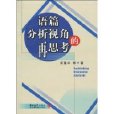《語篇分析視角的再思考》著重介紹了以Fairclough,vanDijk和Wodak為代表的批評性語篇分析的三大主要流派,並且探討了語篇與社會、身份的敘事建構、語篇、意識形態與權力、性別與語言的關係。此外,上述語篇分析理論和方法在8篇範文中得以套用,希望能夠起到一定的示範作用,促進語篇分析理論與實踐的結合。希望《語篇分析視角的再思考》能夠對於國內的語篇研究人員和研究生具有一定的借鑑意義。
基本介紹
圖書信息,作者簡介,圖書目錄,
圖書信息
書 名: 語篇分析視角的再思考
ISBN: 9787560150727
開本: 16開
定價: 24.00 元
作者簡介
項蘊華(1967-),女,江蘇無錫人,2005年6月在南開大學外國語學院英語系獲得文學博士學位,現任吉林大學外國語學院教授,碩士生導師,吉林大學哲學社會學院博士後。其主要研究方向為(批評性)語篇分析、社會語言學和語言哲學。先後在《外語學刊》、《吉林大學社會科學學報》、《山東外語教學》《哲學動態》和《社會科學研究》等核心期刊上發表過學術論文。目前正在承擔語篇分析和語言哲學領域的科研項目。
圖書目錄
Part I Discourse Analysis Theory
Chapter 1 An Introduction to Discourse Analysis
1.1 Language
1.1.1 Saussure's view of language
1.1.2 Bloomfield's view of language
1.1.3 Chomsky's view of language
1.1.4 Functionalist view of language
1.1.5 Volosinov and Bakhtin' s view of language
1.1.6 Foucault's view of discourse
1.1.7 Comparison among different views of language
1.2 Linguistic forms and functions
1.2.1 Spoken language and written language
1.2.2 Utterances and sentences
1.2.3 The functions of language
1.3 Text
1.3.1 The treatment of texts
1.3.2 Properties of texts
1.3.3 Summary
1.4 Discourse Analysis
1.4.1 Discourse
1.4.2 The development of discourse analysis.
Chapter 2 Critical Discourse Analysis
2.1 An introduction to CDA
2.1.1 Development of CDA
2.1.2 Basic notions of CDA
2.1.3 Research areas and topics
2.1.4 Methodologies of CDA
2.1.5 Summary
2.2 The Dialectical-Relational Approach.
2.2.1 Key notions
2.2.2 Analytical devices
2.2.3 Methodological issues in crisis research
2.2.4 Fields of application
2.2.5 Cultural Political Economy Research Centre.
2.2.6 Comments
2.3 The Socio-Cognitive Approach
2.3.1 The discourse-cognition-society triangle.
2.3.2 Analytical devices
2.3.3 Context Models
2.3.4 Event Models
2.3.5 Ideology and prejudice
2.3.6 Social situations
2.3.7 Related journals
2.3.8 Comments
2.4 The Discourse-Historical Approach.
2.4.1 Key notions
2.4.2 Analytical devices
2.4.3 The Discursive Construction of National Identity
2.4.4 The Discourse of Politics in Action.
2.4.5 Research centres and journals
2.4.6 Comments
2.5 Summary
Chapter 3 Discourse and Society
3 A Kxess' approach
3.1.1 The linguistic reproduction of the social
3.1.2 The social production of language
3.2 Fairclough's approach
3.3 Text structure and social structure.
Chapter 4 Narrative Construction of Identity
4.1 Narrative and narrative analysis
4.2 Narrative analysis of identity construction
4.3 Labov's Evaluation Model
Chapter 5 Discourse, Ideology and Power
5.1 Discourse and Ideology
5.1.1 The strands and assumptions of ideology
5.1.2 The functions of ideology
5.1.3 The cognitive interface between discourse and ideology
5.1.4 The analytical levels of ideological analysis
5.2 Discourse and power
5.2.1 The relationship between discourse and power
5.2.2 Asymmetry of power
5.2.3 Removing markers of power asymmetry
5.2.4 Summary.
Chapter 6 Gender and Language
6.1 Different approaches.
6.1.1 Dominance Approach
6.1.2 (Sub) Cultural Difference Approach
6.1.3 Gender Diversity Approach
6.2 Methodologies of Gender Studies
6.2.1 Introspection
6.2.2 Sociolinguistic Surveys
6.2.3 Focus Groups
6.3 Gender and Talk.
6.3.1 The Deficit Approach
6.3.2 The (Male) Dominance Approach
6.3.3 The (Cultural) Difference Approach
6.3.4 The Performance Approach and Positioning Approach
6.4 Gender and Education
6.4.1 Related Studies in the 1970s and 1980s
6.4.2 Related Studies in the 1990s
6.4.3 Related Studies since 2000
6.5 Gender and Children's Fiction
6.5.1 The Change of Children's Fiction
6.5.2 The Analysis of Children's Fictions
6.6 Gender and Advertisements
6.7 Gender, Ageism and Sexist Discourse
Part Ⅱ Discourse Analysis Practice.
Sample 1
Sample 2
Sample 3
Sample 4
Sample 5
Sample 6
Sample 7
References
Appendix 1
Appendix 2
Appendix 3
Appendix 4
Appendix 5
後記
……

